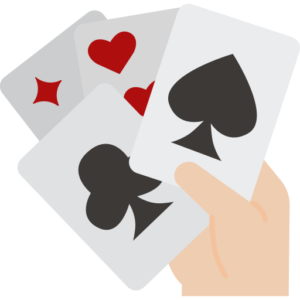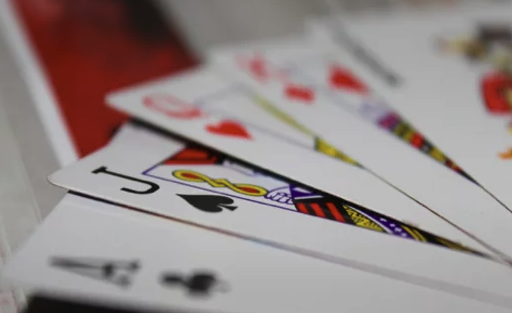Glossary Term
Backdoor Draw
Backdoor Draw
Used In: Poker
Introduction
A backdoor draw in poker occurs when a player has the potential to complete a strong hand, but only if they get lucky with the next two community cards. This draw usually involves the turn and river. For example, if a player has four cards to a flush after the flop, they need both the turn and river to complete the flush. The term “backdoor” reflects how the player can still improve their hand, but only through a series of fortunate outcomes.
In many cases, a backdoor draw is a long shot. The player doesn’t have the immediate chance to complete their hand after the flop, unlike open-ended or straight draws that can be completed with just one card. Because it requires two specific cards, the odds of hitting a backdoor draw are generally low. Players often use these draws strategically, knowing that while they might be behind, they still have the chance to catch up if the right cards come.
Backdoor draws are important to recognize in poker because they can lead to unexpected wins. Even when a player doesn’t have a strong hand initially, they might still be in the game due to the possibility of hitting a backdoor draw. However, because of the low probability of completing these draws, they should be used carefully in betting decisions. Relying too heavily on a backdoor draw can be risky, but it can also create opportunities for a surprise win when the cards fall in the right way.
In Depth Look
A backdoor draw in poker is a situation where a player can complete a strong hand, but only if the right cards appear on both the turn and river. It typically occurs when a player has four cards that could potentially form a hand, such as a flush or straight, but lacks the immediate completion. For example, with four cards to a flush after the flop, the player needs the right suit on both the turn and the river to complete the flush. Since this type of draw requires two specific cards, it is considered a more remote, or “long shot,” way to improve a hand, compared to other types of draws like an open-ended straight draw that can be completed with just one card.
The odds of hitting a backdoor draw are relatively low. To understand why, consider that you need to hit a particular card twice in a row. In contrast to more straightforward draws, such as an open-ended straight draw, where you only need one card to complete the hand, the backdoor draw relies on luck and timing. As a result, players often view backdoor draws as risky. However, they can sometimes be worth pursuing if the player is already invested in the hand or has a strong read on their opponents. Players need to carefully assess the risk versus reward when deciding whether to chase a backdoor draw, considering factors like pot odds and the texture of the board.
Backdoor draws can have a big impact on poker strategy, especially in no-limit games where players are often willing to take calculated risks. A key factor in deciding to pursue a backdoor draw is the potential value of the hand if completed. For instance, if a player has a backdoor flush draw on the flop, the odds of completing the flush by the river might not be great, but if they hit, it could result in a strong hand that could win a big pot. Additionally, backdoor draws can influence the dynamics of a hand, especially when players are trying to bluff or represent a strong hand. They add an element of surprise and uncertainty, which can work to a player's advantage in certain situations, but relying on them too heavily without a strong strategy can be a mistake.
Mechanics
A backdoor draw in poker refers to a situation where a player needs two specific cards to complete a strong hand, typically a straight or flush. This occurs when the player has a draw on the flop, but the necessary cards to complete the hand don’t appear until the turn and river. For example, if a player holds two hearts, and the flop shows two more hearts, the player needs another heart on both the turn and the river to complete a flush. This is known as a backdoor flush draw. Similarly, for a backdoor straight draw, the player would need two specific cards in sequence, one on the turn and one on the river, to complete the straight.
The odds of hitting a backdoor draw are lower compared to hitting a standard straight or flush draw, as the player must rely on two consecutive cards instead of one. On the turn and river, the player needs to hit both cards to complete their hand, which makes it a less reliable draw. Despite the lower probability, backdoor draws can still offer value in certain situations, especially when the pot odds justify the risk. Players with a backdoor draw often need to weigh their chances of completing the hand against the strength of their opponents’ hands and the size of the pot when deciding whether to continue in the hand.


Illustrated Example
Joe is playing Texas Hold'em and has a hand of 8♠ 10♠. The flop comes down as 6♣ 3♦ Q♥. At this point, Joe has no immediate hand, but he has a backdoor flush draw with two spades in his hand. The turn brings the 4♠, giving Joe three spades, and now he’s hoping for another spade on the river to complete a backdoor flush. The river reveals the 2♠, giving Joe a flush with five spades (8♠ 10♠ 4♠ 2♠), even though he didn’t have a flush draw on the flop. This shows how backdoor draws can create surprise hands when the right cards arrive on the turn and river.
Here’s a table showing the situation:
| Street | Joe’s Hand | Community Cards | Flush Draw? | Outcome |
|---|---|---|---|---|
| Pre-flop | 8♠ 10♠ | – | No | – |
| Flop | 8♠ 10♠ | 6♣ 3♦ Q♥ | No | – |
| Turn | 8♠ 10♠ | 6♣ 3♦ Q♥ 4♠ | Yes (3 spades) | One card away |
| River | 8♠ 10♠ | 6♣ 3♦ Q♥ 4♠ 2♠ | Yes (4 spades) | Completed flush |
This illustrates a backdoor flush draw where Joe needed two spades on the turn and river to complete his flush, turning an otherwise weak hand into a strong one.
Player Perspective
A backdoor draw can be both exciting and risky. It offers the chance to complete a strong hand, but the odds of hitting the required cards are relatively low. A player holding a backdoor flush or straight draw might see the turn and river as their last opportunity to improve. In many cases, they’re not expecting to hit the draw, but the possibility of turning a weak hand into a winning one can justify continuing in the hand. The key is to carefully assess the pot odds and the size of the bet, as chasing a backdoor draw without proper value can be a losing strategy.
However, while backdoor draws can sometimes lead to surprise wins, relying on them too heavily can be a dangerous approach. A player needs to remain cautious and avoid chasing them just because they’re hopeful of hitting the right cards. It’s essential to understand the low probability of completing a backdoor draw and balance that risk with the overall game situation. A player might also use a backdoor draw to their advantage by bluffing or representing a stronger hand, but doing so requires a good understanding of the opponent’s behavior and the board’s texture.
Conclusion
In conclusion, a backdoor draw in poker is a situation where a player has the potential to complete a strong hand by hitting specific cards on both the turn and river. While the probability of hitting a backdoor flush or straight is relatively low, it still provides an exciting opportunity for players to improve a weak hand. From a player’s perspective, chasing a backdoor draw can be risky, but it may be worth pursuing depending on the pot odds, betting patterns, and overall game dynamics. However, it’s important to balance the potential rewards with the low likelihood of success, and players should avoid relying too heavily on backdoor draws in their strategy.
The Top Online Casinos for Playing Poker
These platforms prioritize player satisfaction by providing intuitive interfaces, seamless gameplay experiences, and robust security measures to ensure a fair and enjoyable environment for all users.


Author
Branimir Ivanov | Senior News Contributor







